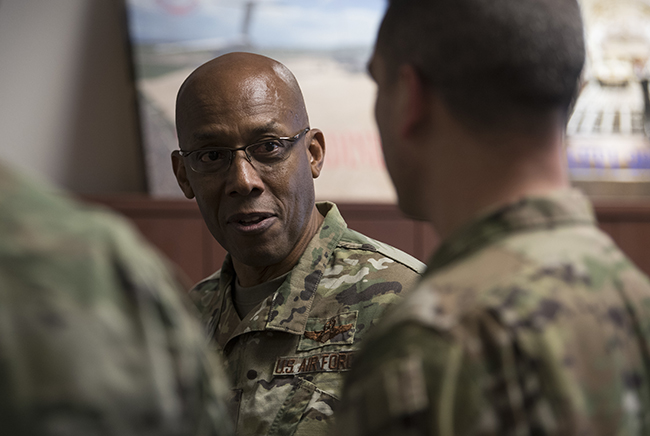
Pacific Air Forces boss Gen. C.Q. Brown discusses PACAF mission readiness with an airman from the 517th Airlift Squadron during a tour at JB Elmendorf-Richardson, Alaska, on Feb. 11, 2019. Air Force photo by A1C Caitlin Russell.
Joint exercises between Russia and China and a recent joint bomber patrol that violated South Korean airspace add a new, worrisome wrinkle to US security posture in the Indo-Pacific region, as does growing competition at the North and South Poles, the head of Pacific Air Forces said.
Gen. C.Q. Brown, at a July 30 AFA Mitchell Institute event, said the July 23 bomber patrol—in which Chinese H-6s and Russian Tu-95s flew together around Japan and South Korea, penetrating the Korean air defense identification zone and prompting intercepts from Japanese and South Korean fighters—is “a potential harbinger of things that could happen in the future.”
Coupled with Chinese and Russian cooperation at the “Vostok” exercises last year, Brown said the nations’ growing coziness is concerning. Russia also “circumnavigated” Taiwan with a bomber, Brown said, alleging Russia had diplomatic clearance from China to do so.
“I do have a concern that they may start collaborating or working together,” Brown said. “It will make it more challenging for us and our partners, and doing things that will actually drive a rift or a wedge in certain areas.”
He acknowledged that the 2018 National Defense Strategy pivots to great-power competition with China and Russia, but said the NDS didn’t anticipate the two competitors joining forces: “It’s something to pay attention to.”
Of the two nations, Brown called China the chief US concern and noted that China is expanding the reach and frequency of its long-range air patrols well beyond its regional waters.
The US intelligence community’s 2019 worldwide threat assessment noted that Russia and China are now more aligned than at any point since the 1950s, especially as their “threat perceptions converge.” Intel experts anticipate the two countries will team up to counter US efforts to promote democracy and human rights abroad, “taking advantage of rising doubts in some places about the liberal democratic model.”
Russia and China are also trying to partner with other countries as a “counterweight” to the US and its alliances, and have expanded their military cooperation since 2014, the report said.
Brown also pointed to state competition spilling into the Arctic and Antarctic regions, arguing now is the time to prepare to operate in those areas. The New York Air National Guard flies the service’s only fleet of 10 ski-equipped LC-130s to Greenland and Antarctica. Brown said the US needs more icebreaking ships as well.
“If we’re going to be challenged in the Arctic and the Antarctic, perhaps we need to preserve that capability—we may need more,” Brown said.
A treaty that protects Antarctica from exploitation and colonization expires in 2048, and Russia and China are already planning ahead for when it does, Brown said. A Chinese icebreaker that was damaged as it carried US National Science Foundation assets to the South Pole went back to China instead of New Zealand for repairs: “Coincidence” Brown asked.
The US needs to collectively contemplate those issues as the treaty winds down, he said.
The buildup of F-35 Joint Strike Fighters in the Pacific is capturing Brown’s attention as well. Thirty Marine Corps, Japanese, Australian, and South Korean F-35s are in the region already, and 220 are expected to be based in the area by 2025.
Eventually, Brown expects 75 percent of F-35s in the Pacific will be owned by US partners. The Air Force plans to field the F-35A in the region next year, with a squadron at Joint Base Elmendorf-Richardson, Alaska. The service should start thinking about how it could spread out and deploy an aircraft unit to a more austere location that may not be able to talk to other parts of the military in case tensions rise with China, Brown added.
Brown pointed to greater cooperation between air and naval forces in the Pacific and touted the importance of the services’ new Long Range Anti-Ship Missile. Both services can use the stealthy derivative of the Joint Air-to-Surface Standoff Missile to attack enemy ships, the general said, and the Air Force must also grow its stocks of precision and standoff weapons in US Indo-Pacific Command.
